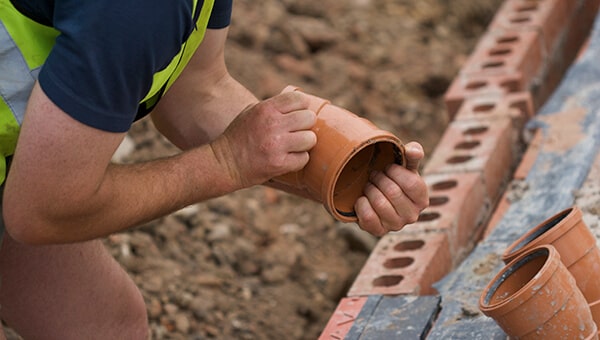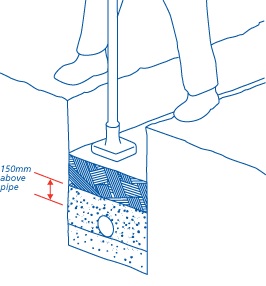Posted: 12th January 2023 | Author: Jamie Brown
Back to news(1).jpg) |
| img: Underground drainage fittings layout |
Domestic underground drainage, or foul drainage, refers to the network of pipes, manholes, and other structures that are used to collect and transport sewage and surface water away from homes and other buildings in the United Kingdom. This system is a crucial part of the infrastructure that keeps our homes and streets clean and hygienic, and it is the responsibility of homeowners and property owners to ensure that their underground drainage is properly maintained.
Surface water drainage is a crucial aspect of modern construction, as it helps to prevent water damage to buildings and other structures. The system is designed to collect water from hard surfaces such as roofs, driveways, paths, and patios and transport it away from the building.
Roof drainage is the above-ground component of the surface water drainage system. It consists of gutters and downpipes that collect water from the roof and channel it into the underground drainage system. The gutters are typically made of metal, plastic, or rubber, and are installed along the edge of the roof to catch and channel water from the roof into downpipes. Downpipes are vertical pipes that are connected to the gutters and carry the water from the roof to the underground drainage system.
It's important to note that the surface water drainage system is separate from the foul water drainage system which carries waste and sewage. A separate system of pipes and manholes are responsible for this.
Overall, the surface water drainage system is a complex network of pipes and components that work together to prevent water damage and keep buildings and surrounding areas safe and dry.
How Does Domestic Underground Drainage Work?
 |
| img: builder installing drainage |
In a typical domestic underground drainage system, rainwater and other surface water is collected by gutters and downpipes on the roof of a building and directed into a network of underground pipes. These pipes, which are usually made of plastic or clay, transport the water to a manhole, which is a large, above-ground structure that allows access to the underground drainage system. From the manhole, the water is carried through a series of larger pipes to a treatment plant or other disposal site, where it is treated and released into the environment. All the flow is gravity based so pipes require a small fall to assist in this process.
The standard UK domestic underground drainage size is 110mm (4”) and in new builds and extensions is most commonly plastic uPVC in terracotta colour rather than the legacy clay.
Domestic underground drainage refers to the system of pipes and fittings that is installed beneath the ground in order to collect and dispose of rainwater and waste water from a house or building. This type of drainage system is necessary in order to prevent water from accumulating around the foundation of a house or building, which can cause structural damage and create a breeding ground for pests and diseases.
There are several steps involved in installing an underground drainage system for a domestic property in the UK:
It is important to note that installing an underground drainage system can be a complex and time-consuming process, and it is generally recommended that it be carried out by a professional contractor with experience in this type of work.
 |
| img: Diagram showing the fall of underground drainage pipe |
Domestic underground drainage falls refer to the slope or gradient of the pipes in an underground drainage system. The term "fall" refers to the difference in elevation between the inlet and outlet of the pipes, and it is important to ensure that the fall is sufficient in order to allow the water to flow through the system properly.
There are several factors to consider when designing the falls for an underground drainage system:
It is important to ensure that the falls in an underground drainage system are properly designed and installed, as a lack of sufficient fall can cause problems such as slow drainage, blockages, and flooding. It is generally recommended that this type of work be carried out by a professional contractor with experience in drainage design and installation.
 |
|
img: Compaction of materials above minimum of 150mm shingle
|
Shingle is a type of small, angular stone that is often used in the installation of underground drainage systems. It is typically used to cover and protect the pipes in the drainage system, as well as to provide a stable and permeable surface for water to flow over.
There are several benefits to using shingle in the installation of underground drainage systems:
Overall, the use of shingle in the installation of underground drainage systems helps to protect and support the pipes, as well as to facilitate the proper drainage of water away from the property.
A uPVC (unplasticized polyvinyl chloride) underground drainage system is a type of drainage system that is commonly used in residential and commercial properties. The main components of a PVC underground drainage system include:
Despite their importance, underground drainage systems are not immune to problems. Some common issues that can occur include:
It is important for homeowners and property owners to regularly maintain their underground drainage systems to prevent problems and ensure that they are functioning properly. Some simple steps you can take to maintain your system include:
Do I need planning permission to make changes to Underground Drainage at a property?
You may not need to apply for planning permission for repairs, maintenance, and minor changes to underground drainage at your home in the UK, but it's always best to check with your local council. Permitted development rights may apply for larger changes, but it's important to confirm this with the local planning authority. Before making any changes, it's important to clarify ownership and responsibility for the drainage system, as it may be shared with neighbours or owned by a sewerage company. Failing to comply with relevant standards or legislation could result in legal and financial consequences. It is recommended to seek advice from your local planning authority.
You may need permission from your local council to make changes to the underground drainage at your home in the UK. This is typically done through the building control department and is known as a building regulations application. They will need to approve the plans for the changes to ensure that they comply with local building codes and regulations. Additionally, if you live in a conservation area or have a listed building, you may need to apply for planning permission as well.
Back to news
The Author: Jamie Brown
From my early working life as a labourer, then becoming a builder and a property developer, I have been buying and using building materials for over 25 years. I set about to start a builders merchant which can offer high-quality products and significant savings along with speedy delivery to keep your sites moving. Still having a foot in the construction industry on my own property, I always make sure the products we sell are up to our high standards which is important for us to keep a great image for the company and superior reputation to supply quality!